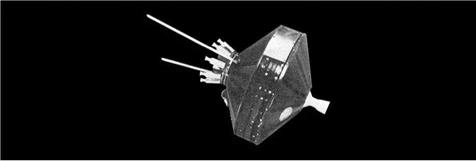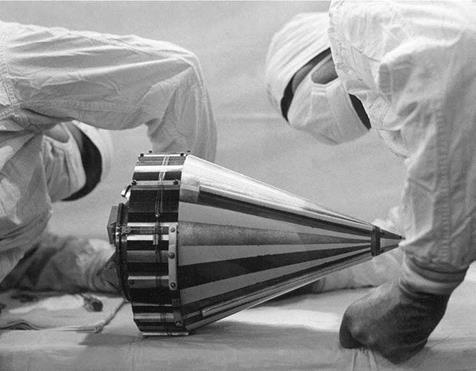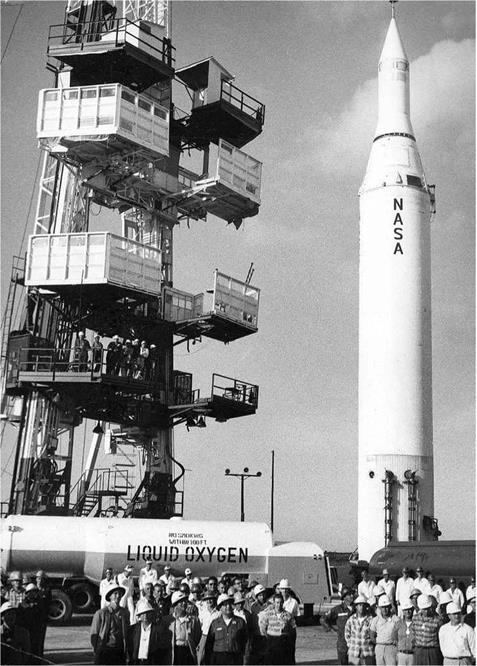AMERICA TRIES FOR THE MOON
Explorer 1 restored national honour, but the Department of Defense was deeply concerned that the Soviet launch vehicle was so much more powerful than its own. On 7 February 1958 President Eisenhower created the Advanced Research Projects Agency headed by Roy W. Johnson, who would report directly to the Secretary of Defense. Its was to develop national goals and coordinate, but not itself conduct, the necessary research.
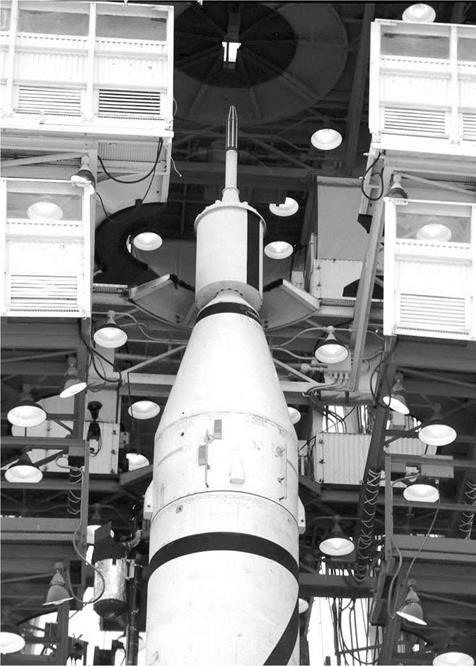
|
|
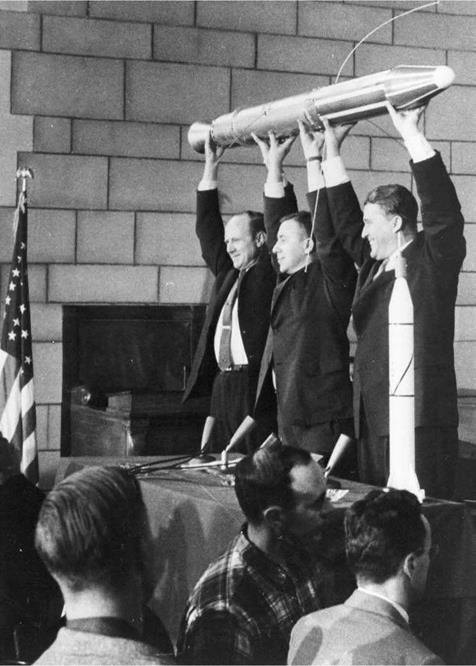
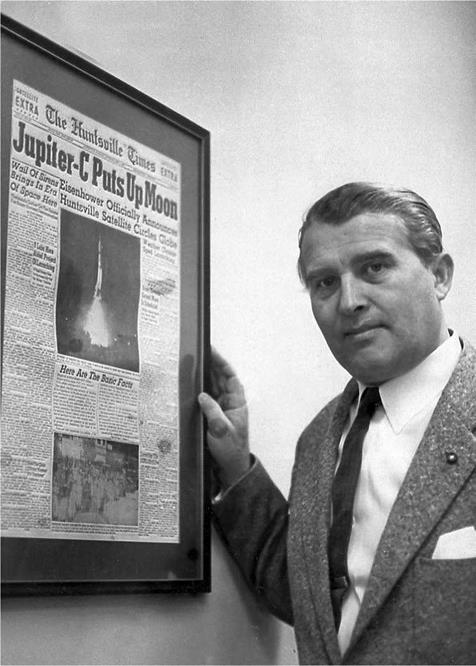
|
On 21 October 1957, three weeks after the launch of Sputnik, W. H. Pickering, since 1954 Director of the Jet Propulsion Laboratory (JPL) in Pasadena, California, had proposed that a spin-stabilised probe be launched towards the Moon, possibly as soon as June 1958.2 The purpose of this Project Red Socks would be to produce “a significant technological advance over the Soviet Union” that would enable America to “regain its stature in the eyes of the world”. The Pentagon sent the proposal to Roy Johnson, who was eager “to surpass the Soviet Union in any way possible”. The fact that the Soviets had not yet announced a lunar flight prompted him to accept the challenge of America being the first to do so. Neil H. McElroy, who had superseded Charles Wilson as Secretary of Defense just a few days before the Soviets launched Sputnik, announced on 27 March 1958 the US decision to “determine our capability of exploring space in the vicinity of the Moon, to obtain useful data concerning the Moon, and provide a close look at the Moon”. It would be undertaken as part of America’s contribution to the International Geophysical Year.
The project was named Pioneer. To pre-empt calls for it to be assigned to one or other of the services, the Air Force and Army were to work in parallel on their own contributions. The Air Force would modify its Thor missile to use the upper stages made for Vanguard. Meanwhile, the Army, just as it had used the Jupiter-C variant of the Redstone in a configuration named Juno I to launch Explorer 1, would fit its Jupiter missile with upper stages by clustering solid rockets to create the Juno II. As conceived, there would be five flight opportunities: three for the Air Force and two for the Army.
The Air Force assigned the technical direction of its part of the project, including the provision of the payload, to the Space Technology Laboratories of Redondo Beach, California. This company served as the contract manager for the Air Force’s ballistic missile program. The plan was for the launch vehicle to undertake a ‘direct ascent’ from Earth and release the probe on a trajectory that would enable it to enter orbit around the Moon. The design of the probe was finished in June 1958, just three months after the project was given the go-ahead. It comprised a pair of squat cones with their bases on a short cylindrical section. The body was 74 cm in diameter and 46 cm tall. It was to be spun at 200 rpm for stability. The mass of 38 kg included the solid-fuelled retro-rocket to brake into lunar orbit and 18 kg of scientific payload. The Advanced Research Projects Agency stipulated that the probe have an imaging system, but the scientists considered the primary payload to be their instruments to follow up the discovery by Explorer 1 of charged-particle radiation near Earth, and in this case the ‘particles and fields’ instruments were a magnetometer to measure magnetic fields in cislunar space and a micrometeoroid impact counter.
At 12:18 GMT on 17 August 1958 the Thor-Able lifted off from Pad 17A at Cape Canaveral, but the seizure of a turbopump bearing 77 seconds later brought the
|
A model of the Pioneer 1 satellite. |
flight to a premature end. Intended to be named Pioneer 1, this inauspicious start entered the history books as Pioneer 0.
Meanwhile, Lyndon Johnson began to argue for a new government agency to run a major space program – it featured in a speech he gave in January 1958 in which he ‘signalled’ his intention to seek the party’s nomination to run for the presidency in I960.
As Eisenhower’s Special Assistant for Science and Technology, James R. Killian chaired the President’s Science Advisory Committee. This reported ‘‘space’’ to be ‘‘inevitable’’, citing as reasons: (1) defence implications, (2) national prestige, and (3) opportunities for scientific research. The Committee warned that if the Pentagon was allowed to run a ‘national’ program, grandiose proposals would jeopardise the scientific work. It would be better to organise the scientific program independently of the military. The Committee recommended assigning it to a body modelled on the National Advisory Council for Aeronautics, which had been established in 1915 to coordinate aeronautical research. On 2 April 1958 Eisenhower signed an executive order calling for the National Advisory Council for Aeronautics to be subsumed into the National Aeronautics and Space Administration (NASA) in order to manage the national civilian space program. He also created the National Aeronautics and Space Board to advise on policy. The National Aeronautics and Space Act was passed by Congress on 16 July, and signed into law on 29 July. The new agency inherited all of its predecessor’s facilities: the Langley Aeronautical Laboratory at Langley Field, which had been established in Hampton, Virginia, in 1917, together with its Pilotless Aircraft Research Station at Wallops Island; the Ames Aeronautical Laboratory at Moffett Field, established in 1939 in Mountain View, California; the Lewis Flight Propulsion Laboratory, which was established in 1941 in Cleveland, Ohio; and the High-Speed Flight Station, established in 1949 at Muroc Field in the high desert of California and renamed Edwards Air Force Base in 1950.[6] Although NASA’s remit
was much broader than that of its predecessor, it did not immediately gain control of the rocketry expertise at either JPL or the Army Ballistic Missile Agency.[7]
On 8 August Thomas Keith Glennan, for the last decade President of the Case Institute of Technology in Cleveland, Ohio, was nominated as NASA Administrator. Hugh Latimer Dryden, Director of the National Advisory Council for Aeronautics since 1947, was to provide continuity by serving as his deputy. Congress confirmed the appointments within days. When NASA became operational on 1 October 1958, it inherited the Pioneer project from the Advanced Research Projects Agency.
The Air Force’s second probe rose from Pad 17A at 08:32 GMT on 11 October. The Thor performed flawlessly, but a guidance error caused the second stage to shut down prematurely. The third stage took over, but was incapable of making up the 250-m/s shortfall in velocity. Pioneer 1 was successfully released, but upon attaining an altitude of 115,350 km, about one-third of the way to the Moon, it fell back and burned up in the atmosphere on 13 October. The trajectory precluded the electronic TV imager from viewing the Moon. The scientists welcomed the data provided by the magnetometer and micrometeoroid detector. This flight also had an ion chamber supplied by James van Allen, but it developed a leak and the data was difficult to interpret.
The scientists augmented the third probe with a proportional counter supplied by the University of Chicago. The Thor-Able lifted off at 07:30 GMT on 8 November 1958. The first two stages worked, but the engine of the third stage failed to ignite. The trajectory of Pioneer 2 peaked at an altitude of only 1,550 km and it fell back into the atmosphere 6.8 hours after launch, having returned no significant data.
The Army’s probe was developed by JPL, which had supplied Explorer 1. It was a cone mated at its base to a cylindrical section, stood 51 cm tall and had a maximum diameter of 24 cm. Whereas the Air Force had used an optical-electronic sensor that scanned as the probe rotated, JPL designed a camera whose film would be wet – developed, scanned optically and transmitted to Earth for reproduction by facsimile methods. The image was to be taken from a lunar altitude of 24,000 km, with the shutter being triggered when a photocell noted the presence of the Moon in its field of view. The first flight was to test this sensor. Its successor would carry the entire camera and loop around the back of the Moon to take a picture of the mysterious far-side at a resolution of 32 km. However, when studies by Explorers 3 and 4 revealed that the charged-particle radiation in the Earth’s vicinity would ‘fog’ the film of the Moon-bound probe, the Army cancelled the film camera in August 1958
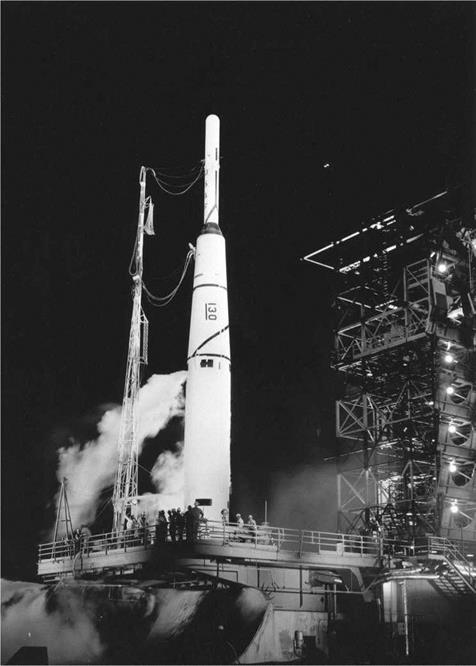
|
|
Technicians prepare the Pioneer 3 satellite. |
in favour of the development of a lightweight slow-scan TV camera and a magnetic tape recorder to store the image for transmission.
A Juno II launched Pioneer 3 from Pad 5 at 05:45 GMT on 6 December 1958. The probe was intended to make a direct ascent, fly close to the Moon and pass into solar orbit. But the Jupiter first stage shut down prematurely, and the upper stages were unable to make up the 286-m/s shortfall in velocity. The 6-kg probe peaked at an altitude of 102,300 km, fell back and burned up 38 hours 6 minutes after launch. Nevertheless, it produced useful data. In place of the camera, it had a pair of Geiger – Mueller tubes supplied by James van Allen to measure radiation in cislunar space, and these revealed the existence of a second zone of radiation some distance above the one already identified: the intensity peaked at 5,000 km and again at 16,000 km, then diminished to the probe’s peak altitude. At van Allen’s suggestion, the imaging system was deleted from the second probe to enable his instrument to fly again. In addition, lead shielding was installed on one of the Geiger-Mueller tubes to screen out the low-energy charged particles. With the imaging cancelled, the trajectory was revised from a loop around the back of the Moon to a flyby into solar orbit – as had been intended for the first probe. After lifting off at 05:45 GMT on 3 March 1959, Pioneer 4 successfully flew by the Moon at 22:25 on 4 March. Unfortunately, the range of 60,500 km was twice that planned, with the result that the photocell test
|
The Juno II launch vehicle with Pioneer 4 is prepared for launch on 3 March 1959 |
failed – but as there was no follow-up probe available to carry the camera this was of little consequence. The Geiger-Mueller results provided further support for the hypothesis that the Earth’s magnetic field traps charged particles that originate from the Sun.5
The idea of streams of particles flowing outward from the Sun was first suggested by British astronomer Richard C. Carrington. In 1859 he made the first observation of what would later be named a solar flare. The occurrence of a geomagnetic storm the following day prompted him to suspect a connection. In the 1950s the German scientist Ludwig Biermann cited the fact that the tail of a comet always points away from the Sun irrespective of the comet’s direction of travel, as evidence that the Sun emits particles. In 1958 Eugene Parker in America postulated a supersonic flow of high-energy charged particles, primarily protons and electrons, streaming from the corona in the form of a ‘solar wind’. The presence of charged particles circulating in the Earth’s magnetic field strongly supported this hypothesis.











